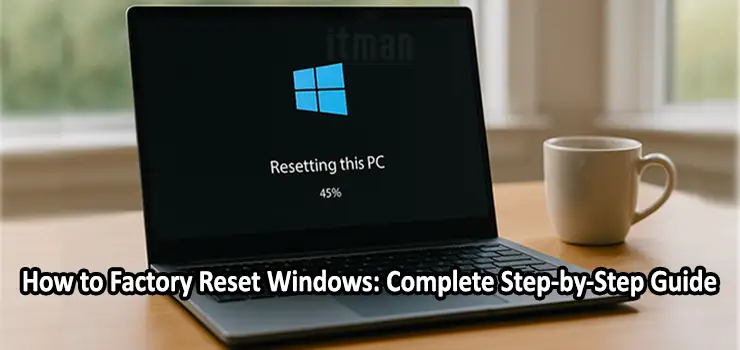A factory reset is one of the most effective ways to restore your computer to its original performance. Over time, Windows systems tend to slow down due to unnecessary files, registry errors, and software conflicts. If your PC is running sluggishly, facing constant errors, or you’re preparing to sell it, performing a Factory Reset Windows process can give it a clean start — as if it’s brand new.
In this detailed guide, you’ll learn what factory resetting means, when you should do it, how to perform it safely, and what to do afterward. Whether you use Windows 10 or Windows 11, this article covers everything step by step.
Many users experience lag and overheating on gaming laptops after long-term use. Performing a Factory Reset Windows can restore original speed and remove performance issues caused by software conflicts.
What Does Factory Reset Windows Mean?
When you Factory Reset Windows, your operating system is reinstalled from scratch. This process removes all personal files, settings, and apps, restoring your PC to the state it was in when you first turned it on. It’s like getting a brand-new installation of Windows without manually formatting your hard drive.
There are two main reset options available in modern versions of Windows:
- Keep my files – Reinstalls Windows but keeps your personal data (documents, pictures, etc.).
- Remove everything – Wipes all data completely, ideal for selling or transferring your PC.
Both options refresh your system and remove software problems caused by corrupted files or unwanted programs.
When Should You Factory Reset Windows?
Performing a Factory Reset Windows is useful in several situations:
- Your PC is running slow despite cleaning and optimization.
- You’re facing persistent crashes, freezes, or blue screen errors.
- Malware or viruses have deeply infected your system.
- You’re planning to sell, donate, or recycle your computer.
- You want a clean environment to reinstall only essential apps.
If any of these apply to you, resetting your PC may be the best way to restore stability and performance.
Important Preparations Before Factory Resetting Windows
Before you start the Factory Reset Windows process, take a few important steps to ensure nothing important is lost and everything goes smoothly.
- Backup Your Data: Even if you choose the “Keep my files” option, always make a full backup. Copy your files to an external drive, OneDrive, or Google Drive. This ensures no data is accidentally deleted.
- Note Down Software Keys and Licenses: If you use licensed software like Microsoft Office, Photoshop, or antivirus tools, record their activation keys. You’ll need them after the reset.
- Disconnect External Devices: Remove unnecessary USB drives, printers, and external hard disks. This prevents any conflicts during the reset process.
- Charge or Plug In Your Device: A factory reset takes time and restarts several times. Make sure your laptop or PC is connected to power.
- Sign Out of Microsoft Account (if selling): If you plan to give away your computer, sign out of your Microsoft account to prevent synchronization of personal data.
How to Factory Reset Windows 10
Windows 10 offers a straightforward way to restore your system. Here’s how to perform a Factory Reset Windows 10 safely.
Step 1: Open Settings
Click on the Start Menu and open Settings (gear icon).
Step 2: Navigate to Recovery
Go to Update & Security → Recovery.
Under “Reset this PC,” click Get started.
Step 3: Choose an Option
You’ll see two options:
- Keep my files
- Remove everything
Choose the one that suits your goal. For a full clean, select Remove everything.
Step 4: Cloud Download or Local Reinstall
Windows will ask if you want to reinstall the OS via:
- Cloud download – Downloads a fresh copy of Windows from Microsoft servers.
- Local reinstall – Uses existing system files stored on your device.
If you have a stable internet connection, choose Cloud download for a cleaner installation.
Step 5: Confirm and Reset
Follow the on-screen prompts. Windows will show what will be deleted. Review and click Reset.
The system will restart several times and complete the Factory Reset Windows 10 process.
How to Factory Reset Windows 11
Windows 11 simplified the reset experience even further, offering a smoother interface and clearer options.
Step 1: Open Recovery Options
Go to Settings → System → Recovery.
Step 2: Start the Reset
Under Reset this PC, click Reset PC.
Step 3: Select Reset Type
Just like in Windows 10, you’ll be asked to choose between:
- Keep my files
- Remove everything
If you want to refresh your computer but keep personal documents, select “Keep my files.”
Step 4: Choose Cloud or Local Reinstall
Pick Cloud download or Local reinstall depending on your preference and connection speed.
Step 5: Confirm and Proceed
Windows will show a summary. Click Next, then Reset to begin.
Your PC will reboot and reinstall Windows automatically.
Once done, you’ll go through the standard Windows setup screen, just like a new device.
What to Do After You Factory Reset Windows
After the reset is complete, your computer will behave like new. However, there are a few important steps you should take:
- Install Windows Updates
Go to Settings → Windows Update and install all available updates for stability and security. - Reinstall Essential Software
Bring back your daily apps — browsers, office suites, and other tools. - Restore Backed-Up Files
Copy your photos, documents, and other data back from your backup drive. - Update Drivers
Ensure all your hardware drivers (graphics, network, audio) are up to date. - Set Up Security
Turn on Windows Defender or install a trusted antivirus for extra protection.
Alternative Method: Factory Reset Windows Using Advanced Startup
If you can’t access the Settings app due to system errors, you can perform a Factory Reset Windows through the Advanced Startup menu.
Step 1: Access Advanced Startup
Press Shift and click Restart from the login or Start menu.
Step 2: Choose Troubleshoot
When the blue recovery screen appears, go to Troubleshoot → Reset this PC.
Step 3: Follow On-Screen Steps
Choose whether to Keep my files or Remove everything, and then select Cloud download or Local reinstall.
Step 4: Wait for the Process to Complete
Windows will reinstall automatically. This method is especially useful if your PC won’t boot normally.

Factory Reset Windows Using Command Prompt (Advanced Users)
Tech-savvy users can also perform a Factory Reset Windows through Command Prompt.
- Boot your PC into Recovery Environment (Shift + Restart).
- Go to Troubleshoot → Advanced Options → Command Prompt.
- Type the following command and press Enter:
Then follow the prompts to reset your PC. This command works for both Windows 10 and 11.
Troubleshooting Common Factory Reset Issues
Sometimes, the Factory Reset Windows process might fail or get stuck. Here’s how to fix it:
- Reset option greyed out: Run Windows Update and try again.
- Stuck at a certain percentage: Wait at least 1–2 hours before restarting; sometimes it just takes time.
- Error message: Boot into recovery mode and use Advanced Startup to retry.
- Missing reset option: Use a Windows installation USB drive and reinstall manually.
Frequently Asked Questions (FAQ)
1. Does Factory Reset Windows delete everything?
If you select “Remove everything,” yes, all personal files and apps will be deleted.
2. Will I lose Windows activation after reset?
No, your digital license remains linked to your hardware and Microsoft account.
3. How long does Factory Reset Windows take?
Typically, between 30 minutes and 2 hours, depending on your system speed and reset type.
4. Can I stop the reset halfway?
Avoid interrupting the process; stopping it can corrupt system files.
5. What if my PC doesn’t boot after reset?
Use a bootable USB with Windows installation media to repair or reinstall.
6. Is Factory Reset Windows the same as reinstalling Windows?
They’re similar, but factory reset is easier and fully automated.
7. Can I Factory Reset Windows without losing data?
Yes, use the “Keep my files” option during reset.
8. Should I back up my files before resetting?
Absolutely. Always back up to prevent accidental loss.
9. Does Factory Reset remove viruses?
Yes, it removes most malware since it reinstalls the operating system.
10. How do I Factory Reset Windows without logging in?
On the login screen, click Power → Restart while holding Shift, then use Troubleshoot → Reset this PC.
Conclusion
Performing a Factory Reset Windows is one of the most powerful ways to restore performance and fix persistent issues without complicated troubleshooting. It gives your computer a clean slate, removes hidden problems, and brings back that “new PC” feeling.
Whether you use Windows 10 or Windows 11, the process is simple and safe if you follow the steps carefully. Always remember to back up your data and reinstall your essential tools afterward. With this guide, you can confidently reset your Windows system and enjoy a smoother, faster, and cleaner computing experience.




















